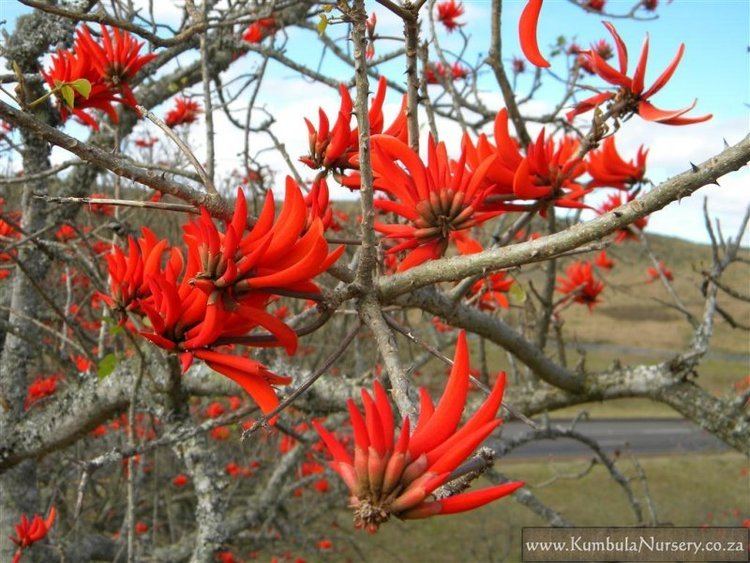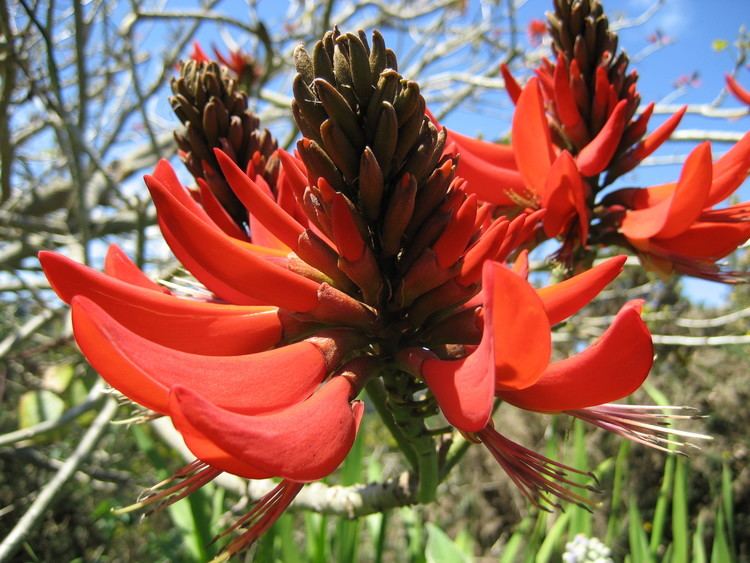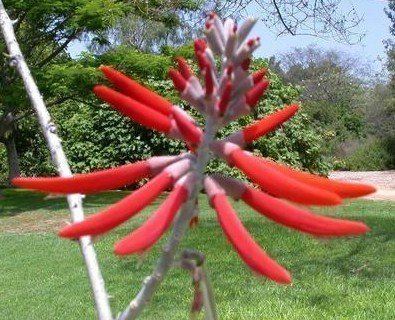Kingdom Plantae Higher classification Phaseoleae | Scientific name Erythrina Rank Genus | |
 | ||
Lower classifications Erythrina crista‑galli, Erythrina variegata, Erythrina mulungu, Erythrina caffra, Erythrina herbacea | ||
Erythrina crista galli in bloom
Erythrina /ˌɛrᵻˈθraɪnə/ is a genus of flowering plants in the pea family, Fabaceae. It contains about 130 species, which are distributed in tropical and subtropical regions worldwide. They are trees, growing up to 30 m (98 ft) in height. The generic name is derived from the Greek word ερυθρóς (erythros), meaning "red," referring to the flower color of certain Species.
Contents
- Erythrina crista galli in bloom
- Beautiful red flower tree cockspur coral tree ceibo erythrina crista galli
- Description and ecology
- Use by humans
- Selected species
- Formerly placed here
- References

Particularly in horticulture, the name coral tree is used as a collective term for these plants. "Flame tree" is another vernacular name, but may refer to a number of unrelated plants as well. Many species of Erythrina have bright red flowers, and this may be the origin of the common name. However, the growth of the branches can resemble the shape of sea coral rather than the color of Corallium rubrum specifically, and this is an alternative source for the name. Other popular names, usually local and particular to distinct species, liken the flowers' red hues to those of a male chicken's wattles, and/or the flower shape to its leg spurs. Commonly seen Spanish names for any local species are bucaré, frejolillo or porotillo, and in Afrikaans some are called kafferboom. Mullumurikku is a widespread name in Kerala.
Beautiful red flower tree cockspur coral tree ceibo erythrina crista galli
Description and ecology

Not all species of Erythrina have bright red flowers; the Wiliwili (E. sandwicensis) has extraordinary variation in its flower colour, with orange, yellow, salmon, green and white all being found within natural populations. This striking color polymorphism is also found in Erythrina lysistemon and Erythrina caffra.
All species except the sterile hybrids E. × sykesii and E. × bidwillii have legume-type fruit, sometimes called pods, containing one of more seeds. The resilient buoyant seeds are often carried by the sea for large distances and are commonly called "sea beans".
Erythrina leaves are used as food plants by the larvae of some Lepidoptera species including the swift moth Endoclita damor and the woolly bears Hypercompe eridanus and Hypercompe icasia. The mite Tydeus munsteri is a pest on the coastal coral tree (E. caffra).
Many birds visit the nectar-rich Erythrina flowers. In the Neotropics, these are usually larger hummingbirds, for example the swallow-tailed hummingbird (Eupetomena macroura) and the black-throated (Anthracothorax nigricollis) and green-breasted mangos (A. prevostii) – though they seem not to be especially fond of E. speciosa at least, which they visit rather opportunistically. In Southeast Asia, the black drongo (Dicrurus macrocercus) which usually does not eat nectar in quantity has been observed feeding on E. suberosa flowers, and mynas and of course more specialized nectar feeders also utilize coral tree flowers. Lorikeets such as the collared lory (Phigys solitarius) and the possibly extinct New Caledonian lorikeet (Charmosyna diadema) are known to consume (or have consumed) large amounts of Erythrina nectar.
Use by humans
Some coral trees are used widely in the tropics and subtropics as street and park trees, especially in drier areas. In some places, such as Venezuela, bucarés are used as shade trees for coffee or cocoa crops. In the Bengal region, they are used for the same purpose in Schumannianthus dichotoma plantations. E. lanceolata in particular is considered highly suitable as "frame" tree for vanilla vines to grow up on.
The conspicuous, even dramatic coral trees are widely used as floral emblems. cockspur coral tree (E. crista-galli) is the national flower of Argentina and Uruguay. The coastal coral tree (E. caffra) is the official city tree of Los Angeles, California, where it is referred to simply as the "coral tree". The state trees of Mérida and Trujillo in Venezuela are bucaré ceibo (E. poeppigiana) and purple coral tree (bucaré anauco, E. fusca), respectively. Yonabaru, Okinawa as well as the Okinawa Prefecture and Pathum Thani Province have the Indian coral tree (E. variegata) as floral emblems. Known as thong lang in Thailand, the latter species is also one of the thong ("trees") referred to in the name of Amphoe Chom Thong, Chiang Mai Province. In a similar vein, Zumpahuacán in Mexico derives its name from Nahuatl tzompahuacá, "place of the Erythrina americana". In Vietnam, people use the leaves of E. variegata to wrap nem (a kind of fermented pork).
In Hinduism, the mandara tree in Indra's garden in Svarga is held to be E. stricta. The same motif is found in Tibetan Buddhism, where the man da ra ba growing in Sukhavati is identified as an Indian coral tree (E. variegata). The concept of the Five Trees of Paradise is also found in Christian Gnosticism. Though as none of the trees is identified as an Erythrina here, the concept might not be as directly related to the Asian religions as some presume.
The seeds of at least one-third of the species contain potent erythrina alkaloids, and some of these are used for medicinal and other purposes by indigenous peoples. They are all toxic to some degree however, and the seeds of some can cause fatal poisoning. The main active compounds in this genus generally seem to be alkaloids, such as scoulerine, erysodin and erysovin (namely in E. flabelliformis), and the putative anxiolytic Erythravine (isolated from Mulungu, E. mulungu). Except for ornamental purposes, growing, selling or possessing Erythrina is prohibited by Louisiana State Act 159 (where the genus is misspelled Erythina).
Selected species
Horticultural hybrids:
